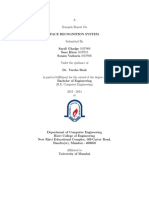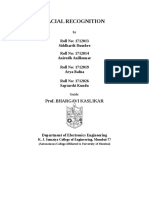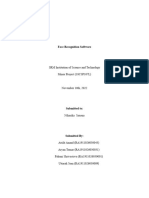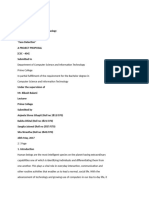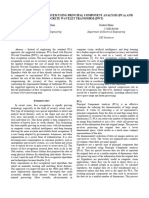Face_recognition_using Python & Opencv
Uploaded by
mskn2331Face_recognition_using Python & Opencv
Uploaded by
mskn2331“Face Recognition Using Python and OpenCV” 2024-25
Face Recognition Using Python and OpenCV
Synopsis
INTRODUCTION
Facial recognition is a biometric tool. The introduction of facial recognition in the field of
pattern recognition had an impact on the range of applicability, particularly for cyber
investigations. This has been possible due to advanced training techniques and progression
made in the analysis. Facial recognition systems could be the best solution due to their speed
and convenience over other biometric technologies. The identity of any person is incomplete
without facial recognition. Just like any other form of identification, face recognition requires
samples to be collected, identified, extracted with necessary information, and stored for
recognition. Afterward, the facial signature is compared to a dataset if known faces. This can
all happen in a matter of seconds Facial recognition technology has been around since the
1960s. When given a photograph of a person, the system could extract images from a dataset
that most closely resembled it. Facial recognition technology is widely used in the field of
safety and security. Today, some companies are developing a service using face recognition
data platforms to help prevent shoplifting and violent crime. Facial recognition is
increasingly used in mobile devices and consumer products to authenticate users. Facial
recognition could also be used for targeting products to specific groups by offering a
personalized experience. Some cities across the world are already working towards banning
real-time facial recognition.
PROJECT OUTCOMES:
Implementing face recognition using Python and OpenCV can lead to several interesting
outcomes and applications. Here are some potential outcomes:
Real-Time Face Recognition: We can develop a system that recognizes faces in
real-time from video streams or webcam feeds. This can be used for applications like
security systems, attendance tracking, or personalized user experiences.
Facial Feature Extraction: The project can involve extracting facial features and
creating embeddings that represent each face. These embeddings can be used to
compare and identify faces accurately.
Department of CS&E, SJMIT, Chitradurga-577502Page 1
“Face Recognition Using Python and OpenCV” 2024-25
Integration with Databases: We can integrate the face recognition system with
databases to verify identities. This can be useful for access control systems, user
authentication, and more.
Machine Learning Models: We can train machine learning models, such as Support
Vector Machines (SVM) or neural networks, to improve the accuracy of face
recognition.
Applications in Various Fields: The project can have applications in security and
surveillance, user authentication, retail (for personalized marketing), healthcare (for
patient identification), and entertainment (for tagging photos in social media).
Dataset Handling: We'll gain experience in handling and preprocessing datasets,
which is a crucial skill in computer vision projects.
SCOPE OF WORK:
The scope of work for a face recognition project using Python and OpenCV can be quite
extensive. Here's a breakdown of the key areas:
1.Data Acquisition & Preparation:
Gathering Dataset: Collect images of individuals to be recognized. This could be done
manually or by leveraging existing datasets.
Preprocessing: Clean the dataset by resizing, cropping, and normalizing images.
Labeling: Assign labels to each image, identifying the person in the picture.
2. Face Detection:
Choosing a Detector:
Select a suitable face detection algorithm (e.g., Haar Cascades, HOG + Linear SVM, or deep
learning-based detectors).
Implementation:
Utilize OpenCV's built-in functions to detect faces in images or video streams.
3. Feature Extraction:
Selecting a Method: Choose a feature extraction technique (e.g., Eigenfaces, Fisherfaces,
LBPH, or deep learning embeddings).
Implementation: Extract relevant facial features for each detected face using OpenCV.
Department of CS&E, SJMIT, Chitradurga-577502Page 2
“Face Recognition Using Python and OpenCV” 2024-25
4. Model Training:
Choosing a Model: Select a suitable classification algorithm (e.g., SVM, k-NN, or neural
networks).
Training: Train the chosen model on the extracted features and corresponding labels.
5. Face Recognition:
Prediction: Use the trained model to predict the identities of faces in new images or video
streams.
Performance Evaluation: Evaluate the accuracy and efficiency of the recognition system.
6. Additional Considerations:
Real-time Recognition: Implement the system for real-time face recognition in live video
feeds.
Handling Variations: Address challenges like variations in lighting, pose, and facial
expressions.
Improving Accuracy: Consider techniques like data augmentation and ensemble methods to
enhance accuracy.
User Interface: Develop a user-friendly interface for interacting with the system.
7. Key Deliverables:
Functional Face Recognition System: A working system capable of detecting and
recognizing faces.
Well-Documented Code: Clear and commented code for maintainability and future
development.
Performance Report: A comprehensive evaluation of the system's accuracy and performance
metrics.
User Guide: Documentation on how to use the system.
METHODOLOGY:
Facial recognition has been approached through various methods over the years.
o Feature-based: In this method, distinct facial features such as mouth, nose, eyes, and
more are of importance. thus, they are extracted as key points with their location
determined and are geometrically processed on them to be represented later by
vectors of distances and angles relating these specific features. Then, pattern
Department of CS&E, SJMIT, Chitradurga-577502Page 3
“Face Recognition Using Python and OpenCV” 2024-25
recognition techniques are used to match the faces using these measurements.
Feature-based matching is considered high-speed since it uses specific features of the
face during the process and extracts them before the analysis starts.
o Holistic: This approach takes the whole face into consideration rather than focusing
on some special features. It deals with 2D face images and works on comparing them
directly to each other and correlating their similarities. Eigenfaces is one of the
methods used and was developed by Sirovich and Kirby. It is one of the most widely
researched face recognition techniques, also known as Karhunen-Loe`ve expansion,
Eigen image, Eigenvector, and a principal component. First, a set of images, known
as the training set, is inserted into a dataset to be compared later with the created
eigen- faces. This tool helps reduce dimensionality to finally represent the eigenfaces
as vectors of weights. Next, the system receives the unknown image that needs to be
recognized and finds its weight to compare with the weights of the training set.
Finally, the image in the dataset with the closest weight to that of the unknown one
will be the output. Although this method’s advantage is that it does not destroy any of
the image’s information, this makes it computationally expensive since it values all
the pixels of the image.
o Hybrid: This type of matching method employs both feature-based and holistic
matching methods on 3D face images.
EXPECTED OUTCOMES:
Face recognition using Python and OpenCV can produce outcomes such as:
Detected faces: A face recognition application can detect faces in an image and draw
rectangles around them.
Trained face recognizer: A face recognizer can be trained to predict if test images
are correct.
Facial embeddings: Facial embeddings can be calculated from extracted faces and
stored in a database.
Closest matching faces: A database can be used to retrieve the closest matching
faces and corresponding photos.
Department of CS&E, SJMIT, Chitradurga-577502Page 4
“Face Recognition Using Python and OpenCV” 2024-25
Real-time face recognition: A face recognition system can perform real-time face
recognition.
Practical Applications: You’ll be able to apply your system in various real-world
scenarios, such as secure login systems, personalized experiences in retail, patient
identification in healthcare, and more.
Portfolio Boost: Successfully completing this project adds a significant achievement
to your portfolio, demonstrating your ability to solve complex problems using
cutting-edge technology.
Enhanced Machine Learning Knowledge: By integrating machine learning models,
you’ll improve your understanding of training models, feature selection, and
evaluating performance metrics.
Problem-Solving and Debugging Skills: You'll improve your ability to troubleshoot
and debug issues that arise during development, which is a critical skill for any
software development role.
SIGNIFICANCE AND INVOCATION:
Face recognition is an essential application in computer vision with wide-ranging uses,
including security, personalization, and human-computer interaction.
Implementing face recognition using Python and OpenCV offers the following benefits:
1. Open Source and Cost-Effective: OpenCV is a free, open-source library that
provides tools for real-time computer vision applications, making it an excellent
choice for projects.
2. Ease of Use: Python's simplicity combined with OpenCV’s pre-built functions
reduces development time for face recognition systems.
3. Customizability: Developers can adapt the algorithm for various purposes, such as
face detection, recognition, or real-time face tracking.
4. Performance: OpenCV leverages optimized libraries and can utilize GPU
acceleration for high-speed processing.
5. Integration: The results can be easily integrated with other applications, such as
attendance systems, surveillance systems, or personalized marketing platforms.
Department of CS&E, SJMIT, Chitradurga-577502Page 5
“Face Recognition Using Python and OpenCV” 2024-25
Common Applications:
Security: Access control in buildings, devices, or software.
Healthcare: Monitoring patients or recognizing faces for identity verification.
Retail: Personalized recommendations or customer tracking.
Social Media: Tag suggestions and user identification.
Here’s an overview of the steps to implement face recognition using OpenCV:
1. Install Necessary Libraries: Install OpenCV and NumPy (commonly required for
image processing)
2. Load and Preprocess Data: Load an image or access a webcam feed. Convert the
image to grayscale for easier computation (if required).
3. Face Detection: Use a pre-trained model like Haar Cascades or the more accurate
DNN-based models.
4. Face Recognition: Utilize libraries such as face_recognition (built on dlib) for facial
feature extraction and matching.
5. Real-Time Face Recognition (optional): Combine face detection and recognition
with live video streams for dynamic applications.
CONCLUSION:
Face recognition is a vital research topic in the image processing and computer vision fields
because of both its theoretical and practical impact. Access control, image search, human-
machine interfaces, security, and entertainment are just a few of the real-world applications
for face recognition. However, these applications confront several difficulties, including
lighting conditions. Numerous research articles on both software and hardware are
highlighted in this document as well as a deep dig into the algorithm’s comprehension,
concentrating mostly on methods based on local, holistic, and hybrid features.
Department of CS&E, SJMIT, Chitradurga-577502Page 6
“Face Recognition Using Python and OpenCV” 2024-25
REFERENCE:
1. ChillWall, “Future of facial recognition technology,” December 2020. [Online].
Available: Future of Facial Recognition Technology - Discover Events and Event
Ideas (chillwall.com)
2. D. N. Parmar and B. B. Mehta, “Face recognition methods applications,” Int. J.
Computer Technology Applications, pp. 84–86, 2013.
3. Alberto Fernández Villán, Mastering OpenCV 4 with Python, Packt Publishing, 2019.
4. Face Detection with Python using OpenCV Tutorial | DataCamp
5. Face Recognition Systems: A Survey - PMC (nih.gov)
6. (PDF) An Overview of Holistic Face Recognition (researchgate.net)
Department of CS&E, SJMIT, Chitradurga-577502Page 7
You might also like
- An Approach For Face Detection and Face Recognition Using OpenCV and Face Recognition Libraries in PythonNo ratings yetAn Approach For Face Detection and Face Recognition Using OpenCV and Face Recognition Libraries in Python5 pages
- Lecture 4 - Bias-Variance Trade-Off and Model SelectionNo ratings yetLecture 4 - Bias-Variance Trade-Off and Model Selection66 pages
- An Approach for Face Detection and Face Recognition Using OpenCV and Face Recognition Libraries in Python (1)No ratings yetAn Approach for Face Detection and Face Recognition Using OpenCV and Face Recognition Libraries in Python (1)5 pages
- Intelligent Facial Recognition and Analytics System - User Alert Functionality With Personalized Notifications-1No ratings yetIntelligent Facial Recognition and Analytics System - User Alert Functionality With Personalized Notifications-12 pages
- Recent Trends of Facial Recognition Approaches For The Internet of ThingsNo ratings yetRecent Trends of Facial Recognition Approaches For The Internet of Things4 pages
- Face Recognition System: Abstract-We Present An Approach To The Detection andNo ratings yetFace Recognition System: Abstract-We Present An Approach To The Detection and6 pages
- Indreni College Institute of Science and Technology: A Project Report On "Face Detection"No ratings yetIndreni College Institute of Science and Technology: A Project Report On "Face Detection"10 pages
- Face Detection and Face Recognition SystemNo ratings yetFace Detection and Face Recognition System7 pages
- Real-Time Face Recognition System Using Python and OpenCVNo ratings yetReal-Time Face Recognition System Using Python and OpenCV6 pages
- Introduction To Innovative Projects Face Recognition (Opencv)No ratings yetIntroduction To Innovative Projects Face Recognition (Opencv)20 pages
- Face Detection and Recognition Using Opencv and PythonNo ratings yetFace Detection and Recognition Using Opencv and Python3 pages
- Attendance System Based On The Face Recognition of Webcam's Image of The ClassroomNo ratings yetAttendance System Based On The Face Recognition of Webcam's Image of The Classroom11 pages
- Face Recognition System With Face DetectionNo ratings yetFace Recognition System With Face Detection10 pages
- Face Detection and Recognition System by Gurupdesh SinghNo ratings yetFace Detection and Recognition System by Gurupdesh Singh93 pages
- Face Recognition Using Haar Cascade Classifier: Varun Garg Kritika GargNo ratings yetFace Recognition Using Haar Cascade Classifier: Varun Garg Kritika Garg3 pages
- Designing Iot Face Recognition Robot: Shreenivas TelkarNo ratings yetDesigning Iot Face Recognition Robot: Shreenivas Telkar5 pages
- Phase-II - PPT - Template-Updated by RizaNo ratings yetPhase-II - PPT - Template-Updated by Riza18 pages
- Teoh 2021 J. Phys. Conf. Ser. 1755 012006No ratings yetTeoh 2021 J. Phys. Conf. Ser. 1755 01200610 pages
- Face Recognition Attendance System Using Python (With Code)No ratings yetFace Recognition Attendance System Using Python (With Code)9 pages
- Face Recognition in Non-Uniform Motion Using Raspberry Pi: 15 IJRE - Vol. 03 No. 05 - May 2016No ratings yetFace Recognition in Non-Uniform Motion Using Raspberry Pi: 15 IJRE - Vol. 03 No. 05 - May 20163 pages
- Face Recognition Using Pca and Neural Network Model: Submitted by Aadarsh Kumar (15MIS0374No ratings yetFace Recognition Using Pca and Neural Network Model: Submitted by Aadarsh Kumar (15MIS037411 pages
- Face Recognition Based On Machine LearningNo ratings yetFace Recognition Based On Machine Learning6 pages
- Vault Box Using Biometric: - Naman Jain (04614803115) - Mohammed Tabish (04514803115)No ratings yetVault Box Using Biometric: - Naman Jain (04614803115) - Mohammed Tabish (04514803115)17 pages
- ASHISH KAMRA - FinalProjectReport - Ashish KamraNo ratings yetASHISH KAMRA - FinalProjectReport - Ashish Kamra32 pages
- Automatic Student Attendance System Using Face RecognitionNo ratings yetAutomatic Student Attendance System Using Face Recognition7 pages
- Facial Expression Recognition Using Matlab1No ratings yetFacial Expression Recognition Using Matlab16 pages
- 1 - Leaf Recognition For Plant Classification UsingNo ratings yet1 - Leaf Recognition For Plant Classification Using6 pages
- Face Recognition Using PCA (Eigenfaces) and LDA (Fisherfaces)No ratings yetFace Recognition Using PCA (Eigenfaces) and LDA (Fisherfaces)20 pages
- Pattern Recognition Letters: A. Morelli Andrés, S. Padovani, M. Tepper, J. Jacobo-BerllesNo ratings yetPattern Recognition Letters: A. Morelli Andrés, S. Padovani, M. Tepper, J. Jacobo-Berlles8 pages
- Facial Recognition Technical Report - Group 2No ratings yetFacial Recognition Technical Report - Group 248 pages
- Face Recognition Using PCA and Wavelet Method: IjgipNo ratings yetFace Recognition Using PCA and Wavelet Method: Ijgip4 pages
- Karhunen-Loève Transform - KLT: Jankees Van Der Poel D.Sc. Student, Mechanical EngineeringNo ratings yetKarhunen-Loève Transform - KLT: Jankees Van Der Poel D.Sc. Student, Mechanical Engineering70 pages
- A Report On Face Recognition Using Principal Component AnalysisNo ratings yetA Report On Face Recognition Using Principal Component Analysis13 pages
- Eigenfaces and Fisherfaces: Naotoshi SeoNo ratings yetEigenfaces and Fisherfaces: Naotoshi Seo5 pages
- Enhanced Smart Doorbell Facial Recognition (Ayman Ben Thabet, 2015)No ratings yetEnhanced Smart Doorbell Facial Recognition (Ayman Ben Thabet, 2015)5 pages
















